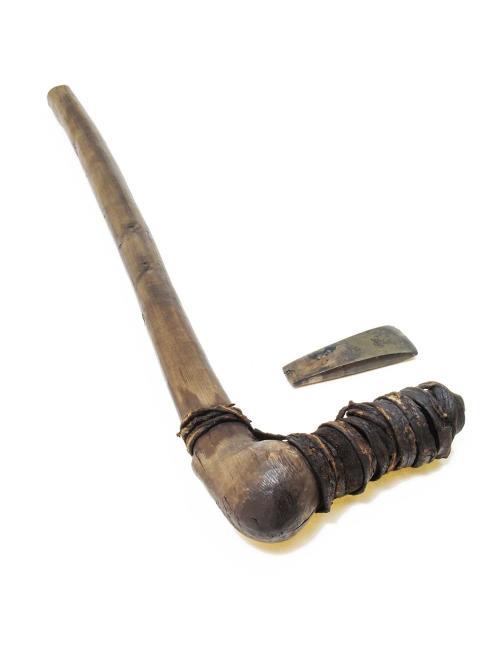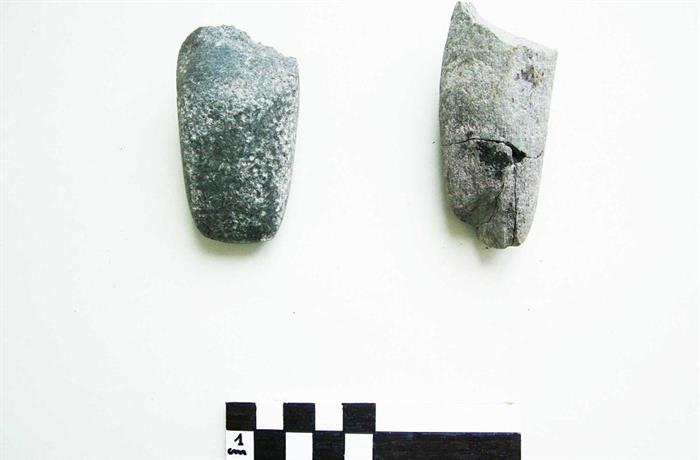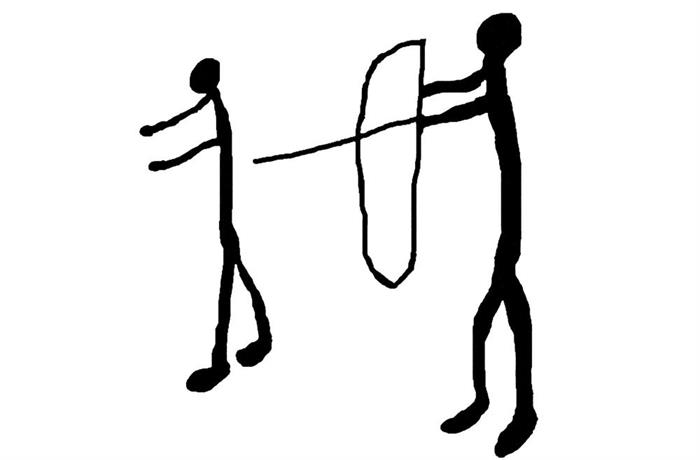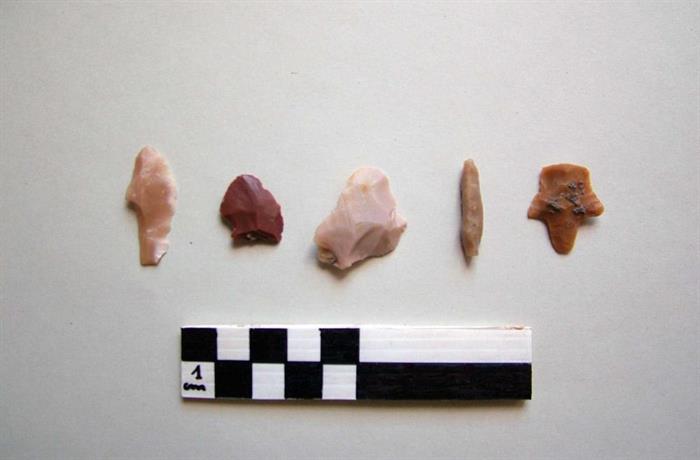Pugnale, ascia e frecce – simboli del potere? // Dagger, axe and arrow – symbols of power?
Osservando il menhir di Laces alcuni motivi balzano subito all’occhio: pugnali e asce. A ben guardare, si vede anche un arco. Questi motivi sono tipici per i cosiddetti menhir maschili del gruppo della Val d’Adige. È interessante che anche Ötzi portava questi oggetti con sé. La sua ascia aveva una lama di rame, mentre il pugnale e le frecce erano di selce. Erano simboli del potere? L’archeologo Hubert Steiner spiega: “Gli oggetti rappresentati sono i primi oggetti realizzati in rame, il nuovo materiale. Pugnali, asce e la fibbia sono indubbiamente simboli di rango dell’età del rame, come confermano anche i cimiteri dello stesso periodo. Ciò dimostra che i menhir rappresentavano personalità di alto rango. Risalgono ad un’epoca caratterizzata da profondi cambiamenti. Il rame portava a un ordine sociale molto più severo e alla formazione di un ceto alto. I menhir quindi danno informazioni importanti sui costumi tradizionali nonché sul tessuto sociale e non da ultimo su convinzioni ideologiche-religiose delle persone. Soprattutto il fatto che i menhir rappresentano persone reali nel loro costume tradizionale o con i loro simboli di rango portava all'idea che ci sia un forte legame con il culto degli antenati e con l’eroizzazione di singoli morti eminenti.”
Some motifs immediately catch your eye when looking at the Laces menhir: daggers and axes. On closer inspection, you can also see a bow. These motifs are typical for the so-called male menhirs of the Adige Valley group. It is exciting that Ötzi also carried these objects. His axe had a copper blade, whereas dagger and arrows were made of flint. Were these symbols of power? The archeologist Hubert Steiner says: “The represented objects are the first achievements made of copper, the new material. Daggers, axes and the cloakpin are undoubtedly symbols of rank of the Copper Age, as cemeteries of the same period make clear. This shows that the picture stones represented high-ranking personalities. They came from an era that was characterized by major upheavals: Copper led to a considerably stricter social order and to the development of an upper class. The menhirs thus provide an insight into the traditional costume but also into the social fabric and not least into the ideological-religious beliefs of the people. It was mainly the fact that menhirs represent real persons in their traditional costumes or with their symbols of rank that led to the idea that they might be closely related to the ancestor worship and the heroization of some outstanding dead people.”

La guaina del pugnale di Ötzi // Ötzi’s dagger sheath
Il pugnale // The dagger
Alcuni pugnali decorano il menhir di Laces. Forse i pugnali rappresentati sono rappresentazioni di pugnali di metallo perché il rame come nuovo metallo emergente era probabilmente molto prezioso nell’età del rame. Ötzi portava con sé un piccolo pugnale che era riposto in un fodero realizzato intrecciando cordini di libro di tiglio. Il suo pugnale aveva una lama in selce e un manico in legno di frassino. Per affilare le lame in selce usava un ritoccatore. Si tratta di un utensile simile a una matita costituito da un ramo di tiglio scortecciato da cui sporge una sottile scheggia di corno di cervo, temprata a fuoco. Ötzi portava anche questo ritoccatore con sé. Durante l’età del rame i pugnali in selce lavorati da entrambe le parti e sulle superfici sono considerati prodotti tipici dell’Italia settentrionale. Spesso sono chiamati anche pugnali di Remedello. Confrontato con altri reperti il pugnale di Ötzi sembra un po’ piccolo e consumato. Ciò implica che il pugnale non era soltanto un simbolo di rango, ma aveva anche un’utilità pratica ed era ampiamente usato. Una lama in selce che apparteneva a un pugnale simile, ma più grande e splendido fu trovata a Coldrano nel comune di Laces. Anche questa lama in selce risale all’età del rame.
Some daggers decorate the Laces menhir. It might be that the represented daggers are representations of metal daggers because copper as an emerging material was very probably very prestigious in the Copper Age. Ötzi carried a small dagger that was in a sheath made of knotted lime tree bast. His dagger had a flint blade and an ash wood handle. He used a retoucheur to sharpen flint tools. This tool was made from the stripped branch of a lime tree and sharpened like a pencil with a fragment from a fire-hardened deer antler that was hammered into the core of the branch. He also carried this retoucheur. During the Copper Age flint daggers processed on the surfaces and on both sides were a typical product from Northern Italy and are often referred to as Remedello daggers. In comparison with other finds, Ötzi’s dagger seems a bit small and consumed, which implies that the dagger wasn’t only a status symbol, but also had a practical benefit and was widely used. A flint blade that was part of a similar but slightly larger and more splendid dagger was found in Coldrano, a village belonging to the municipality of Laces. It also dates back to the Copper Age.

Lama in selce, Coldrano // Flint blade, Coldrano

Pugnali sul menhir di Laces // Daggers on the Laces menhir

Il pugnale di Ötzi // Ötzi’s dagger
L'ascia // The axe
Anche alcune asce decorano il menhir di Laces. Probabilmente si tratta di rappresentazioni di asce di rame. Una potrebbe essere una bipenne. Ötzi portava con sé un’ascia. Si tratta di una piccola ascia con margini appena visibili. È realizzata in rame quasi puro che secondo le ultime analisi proviene da giacimenti di minerali nel sud della Toscana. Sono state trovate molte lame di asce in rame dell’età del rame, ma l’ascia di Ötzi è l’unica preservata con manico. Il manico con testata a gomito è in legno di tasso, la lama di rame è fissata al manico con catrame di betulla e strisce di pelle. Con questa ascia si poteva abbattere alberi. Forse questa preziosa ascia non era neanche pensata come utensile, ma come arma. Per i lavori quotidiani si usavano sicuramente ancora a lungo asce con lame di pietra. Ciò dimostra anche il reperto dell’insediamento dell’età del rame a Laces.
Some axes also decorate the Laces menhir. They probably are representations of copper axes. One of them might also be a double-bitted axe. The represented daggers might be representations of metal daggers because copper as an emerging material was very probably very prestigious in the Copper Age. Ötzi carried an axe. It was a small flanged axe with very poorly developed edges. It was made of almost pure copper that had been obtained from ore mined in South Tuscany according to the latest analysis. While copper axe blades from the Copper Age are known in great numbers, Ötzi’s axe is the only one that is preserved with a shaft. The axe shaft is made of yew, the blade is fixed to the shaft with birch tar and leather straps. You could fell trees with this axe. But maybe this precious axe wasn’t thought as an artifact, but as a weapon. Axes with stone blades were certainly still used for a long time for the daily work, which is also proved by the find from the Copper Age settlement in Laces.

L’ascia di Ötzi // Ötzi’s axe

Asce sul menhir di Laces // Axes on the Laces menhir

Ascia dell’insediamento dell’età del rame a Laces // Axe from the Copper Age settlement in Laces
L'arco // The bow
Sul menhir di Laces si vede un arco che però non è chiaramente identificabile. La rappresentazione di una figura con arco tirato ed ascia dimostra inequivocabilmente l’uso di questo oggetto. Vicino al luogo di ritrovamento della mummia è stato trovato un arco lungo 1,80 m in legno di tasso. Sembra che non era ancora finito e doveva ancora essere munito di corda. Ötzi portava con sé una faretra in pelle che conteneva 12 aste di frecce, due di cui avevano punte di selce. Negli scavi a Laces sono stati trovati alcuni utensili di selce tra cui anche punte di freccia. Anche se la popolazione viveva soprattutto dell'agricoltura, arco e frecce furono probabilmente usati per la caccia. Forse fungevano anche da armi.
A bow is depicted on the Laces menhir, which, however, is not clearly identifiable. The representation of a figure with drawn bow and axe definitely shows the use of this object. A 1.80 m-long bow was found near the site of the find of the mummy. It was made of yew wood, but doesn’t seem to be entirely completed. Furthermore, there was no bowstring. Ötzi also carried a leather quiver with 12 arrow shafts, two of them with flint arrows. The excavations in Laces also revealed some artifacts made of flint. Among them were arrowheads. Even though the population mainly lived on agriculture, bow and arrow were probably used for hunting. They might, however, also have been used as weapons.

Figura con arco tirato // Figure with drawn bow

L’arco e le frecce di Ötzi // Ötzi’s bow and arrow

Punte di freccia dell’insediamento dell’età del rame a Laces // Arrowheads from the Copper Age settlement in Laces
L'equipaggiamento tipico nell'età del rame // The typical equipment in the Copper Age
Scavi di tombe dell’età del rame – innanzitutto il cimitero di Remedello presso Brescia– dimostrano che l’equipaggiamento dell’Uomo del Similaun con arco, frecce, ascia e pugnale nonché i motivi rappresentati sul menhir di Laces erano il tipico equipaggiamento di un uomo dell’età del rame dell’Italia settentrionale. L’archeologo Hubert Steiner spiega: “Ciò dimostra che i menhir rappresentavano personalità di alto rango. Risalgono ad un’epoca caratterizzata da profondi cambiamenti. Il rame portava a un ordine sociale molto più severo e alla formazione di un ceto alto. I menhir quindi danno informazioni importanti sui costumi tradizionali nonché sul tessuto sociale e non da ultimo su convinzioni ideologiche-religiose delle persone. Soprattutto il fatto che i menhir rappresentano persone reali nel loro costume tradizionale o con i loro simboli di rango portava all'idea che ci sia un forte legame con il culto degli antenati e con l’eroizzazione di singoli morti eminenti. I menhir appaiono sempre in gruppi, il che potrebbe essere un’indicazione di una famiglia politicamente dominante.“
Archaeological excavations of cemeteries from the Copper Age – above all the cemetery of Remedello near Brescia – show that the equipment of Ötzi the Iceman with bow, arrows, axe and dagger as well as the motifs represented on the Laces menhir were the typical equipment of a man from Northern Italy in the Copper Age. The archeologist Hubert Steiner says: „This shows that the picture stones represented high-ranking personalities. They came from an era that was characterized by major upheavals: Copper led to a considerably stricter social order and to the development of an upper class. The menhirs thus provide an insight into the traditional costume but also into the social fabric and not least into the ideological-religious beliefs of the people. It was mainly the fact that menhirs represent real persons in their traditional costumes or with their symbols of rank that led to the idea that they might be closely related to the ancestor worship and the heroization of some outstanding dead people. Menhirs always appear as a group, which might be an indication of a politically dominant family.“